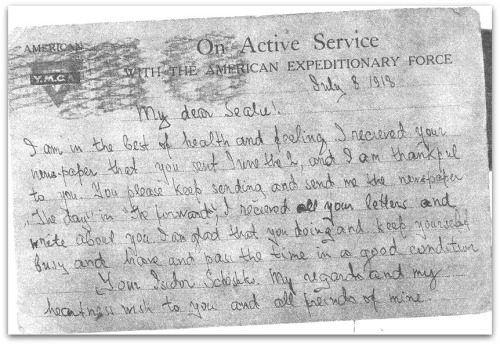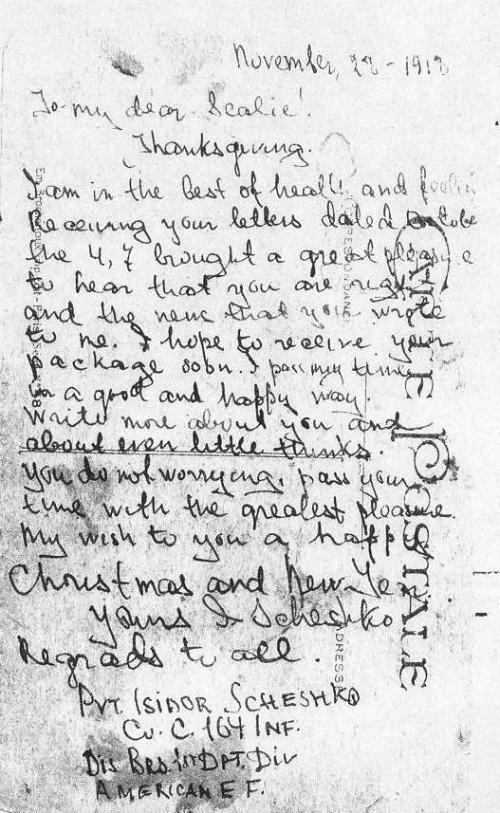Once upon a time I posted on my other family history blog, The Family Kalamazoo, a story about Isidore Scheshko. I am going to repost it here so that has a home where it best belongs.
The gardener’s paternal grandfather, Isidore Scheshko, was born 26 January 1887 in Odessa, Ukraine, but ended up serving the United States army in WWI (and survived the war).
A little over a month before his 27th birthday, Isidore arrived in New York City, planning to become an American citizen.
Four years later, on 23 November 1917, Isidore joined the U.S. Army and two months later was sent overseas for 13 months. His discharge information states that he was not wounded.
What the paperwork doesn’t say is that he was gassed during WWI–something that happened to a great many soldiers during that war. After that, he had a bad stutter. The only person he could speak to without stuttering was his wife, my husband’s grandmother, Celia. Originally, my research didn’t show that the long-term effects of mustard gas include neurological problems, but now I find that indeed it can cause debilitating neurological symptoms.
The gardener says that Isidore was also in the Czar’s army before he immigrated to the U.S. I think he’s a hero for joining up so soon after coming to this country, especially since he had already served in Russia. After all, he was trying to support himself and learn English and he had a girlfriend (yes, Celia).
When I posted about this subject on the other blog, readers seemed sure that this is a U.S. Army uniform from WWI. His legs are in puttees (thank you, Su Leslie).
We have a couple of postcards he sent to Celia while he was away. Here is one from 8 September 1918.
Then two months later:
Notice that he spells Celia’s name Sealie. And his own first name without the E at the end. The fine print legible underneath Isidore’s handwriting is the printed card itself, not postmark information. I don’t know where he was when this was sent, but it was in the middle of the period where he was “overseas.” It might seem surprising that after only four years in the United States, Isidore could write so well in English, but we do believe he wrote these cards himself. In fact, the gardener is sure he wrote them himself. From the first card to the second, he apparently learned that it’s “I before E except after C.”
There is no way to tell from these upbeat notes to “Sealie” that Isidore had been gassed or had, in fact, seen any “action.”
Isidore’s trade as a young man in America was a house painter, and when I think of the fumes he dealt with after he had gone through the gas in the war, it makes me wonder how he lived until 1953. But he didn’t stay a painter; within a few years, he and Celia owned a candy store in Sutton Place in Manhattan where his daughter (my husband’s aunt) went to school for a time with Anderson Cooper’s mother, Gloria Vanderbilt. That didn’t make him rich, but considering what happened during the famine and then WWII in Odessa and Tiraspol, he did well by immigrating to the United States.







Wonderful post, Luanne. I will always be in awe of these young people who left their homes alone and came to the US. My grandfather Isadore (who sometimes spelled it Isidor or Isidore or Isador) also learned English very quickly as well as Italian. Those postcards are such treasures.
It’s fascinating that he did not stutter with Celia but with all others. How would a neurologist/psychologist explain that?
LikeLiked by 1 person
They are treasures! Isidore’s name is also spelled all those ways, but most often Isidore. Then I am uncovering other Isidores, related by marriage. In fact, I think the gardener might have been an Isidore (judging by his Hebrew name) if he’d been born in Europe or in an earlier generation.
Yes the stuttering thing is amazing. I read a memoir once about a person who stuttered and overcame it. It was a manuscript in a writing workshop. I wonder if it was ever published! Let’s hear from a neurologist or psychologist about the stuttering :)!
LikeLiked by 1 person
I hope we do! I do recall hearing that people who stutter can sing words without a problem. Maybe Isadore sang to Celia.
LikeLike
Great stories and cards!
LikeLiked by 1 person
Thanks, WJ! Yes, I think it’s a pretty sweet Valentine’s story!
LikeLike
The difference between learning a language in school and learning a language in a country where the language is used in everyday life is like night and day. You learn so much faster when you hear and use only the new language. This appears to be the case with Isidore learning English. As for the not stuttering with Celia this may likely have been due to his being relaxed and more confident when speaking with his love.
LikeLiked by 1 person
I agree with you about languages. I am one who can study a language wonderfully in class, especially on paper! but I am lousy at actually learning to speak it! I like the immersion technique they use in Israel. Apparently people learn Hebrew very quickly this way. Definitely more relaxed. Maybe it had to do with trust. He probably trusted her implicitly.
LikeLiked by 1 person
He was lucky. We had a relative that was gassed and he only lived a few years when he came back. Technically I don’t know what he died from as the family just says it was from the gas. Immersion is the best for languages. Everyone in my family except me is bi-lingual. German was spoken in the home full time. By the time I came along my grandparents (who spoke no English) were gone so the relatives spoke only English (except when they didn’t want me to know what they were saying!).
LikeLike
I am so happy you reposted this Luanne. I don’t remember if I saw this post before so it was a real treat. What a great story, and the card and letter such a treasure. I am thinking a copy of the postcard made into a Christmas cards for you to send out next year would be so extra, extra special. The letter could go on the inside cover side and your holiday thoughts on the other side. If you do, please you must include me on your card list. I would love to get a card like this. Loved the post Luanne
LikeLiked by 1 person
Wow, Sharon. What an amazing idea. You are so creative! Thank you!
LikeLiked by 1 person
Thanks Luanne on the creativity…just thinking out side the box 🙂
LikeLiked by 1 person
Very clever!
LikeLike
I remember reading this post. Amazing what our relatives have endured.
LikeLiked by 1 person
So amazing!!!
LikeLiked by 1 person
I read this earlier in the week, Luanne, but I’m facing a bunch of deadlines, so I’m just getting back to comment. This is such a wonderful post! Those postcards are such treasures.
My mother’s father joined the navy here during WWI, but he never saw action. My mom said he was a cook. I believe he joined in order to gain citizenship quickly, since his naturalization papers were signed by a military person.
My mother’s artist cousin, Abraham Hankins, was gassed during WWI. It affected his lungs, and as therapy, he did vocal training. I guess he had a very good voice because he went to France for a while and trained there.
LikeLiked by 1 person
Merril, those are fascinating anecdotes. I hope you are collecting them in some way for your family!
LikeLiked by 1 person
Thanks, Luanne. I should probably be more systematic about it. 🙂
LikeLiked by 1 person
It would be good to find a way to record the stories so that you can just do it gradually. It could be by blogging or something more private if that’s what you want.
LikeLiked by 1 person
Some of the stuff is in my “musings,” but it’s in bits and pieces.
LikeLiked by 1 person
Yeah, difficult to sort through for your kids, I imagine. Since you’re proficient in WP you could start a private blog (if you don’t want the responsibility of another public blog haha) for your family and as you think of stories or come across them you could put them there so all the stories are in one place. Then you could even publish it for your family through createspace or some other once you have enough on that blog. Just one of many ideas.
LikeLiked by 1 person
Good idea. 🙂
LikeLiked by 1 person
What amazing artifacts, Luanne! These stories would be solid inspiration for a novel, I think. Any plans in that direction?
LikeLiked by 1 person
Hah! I don’t think so although the gardener suggested Kin Types II is in order!
LikeLiked by 1 person
🙂
LikeLiked by 1 person
Nice…
LikeLiked by 1 person
Luanne this was a great read – thankyou. I have a particular fascination with my own grandfathers vintage postcards – they tell us so much – and yet so very little. Great job. Julie
LikeLiked by 1 person
Thanks, Julie! I do know what you mean. They are tantalizing hints into the lives of the sender and the receiver, aren’t they?!
LikeLike
The photo of him was taken in the same studio as Celia’s pic – look at the pattern on the floor! And yes, that’s a WW1 uniform. I wonder what the X on the arm signifies, though.
LikeLiked by 1 person
I love having your artist’s eye on the photos, Val! Now I wonder what that X means! We’ll have to put this one in the lineup of photos to be colored ;)! I hadn’t noticed about the pattern on the floor. This would make a nice pair with Celia’s. I wonder if they were taken before they got married in 1919. Could it even be the dress she wore to get married in?
LikeLiked by 1 person
I don’t know about photos taken in America, but here in the UK in those earlier times, families often set aside dates to have studio photographs taken for their families, not always a special occasion (unfortunately!) But sometimes, yes, they used the same studio as the rest of the family for a special occasion. I think the one of Celia (that I coloured) was not a wedding photo, it’s not a formal enough dress – and wouldn’t it have been white?
LikeLiked by 1 person
I doubt that Celia would have worn a white wedding dress. In the late 19th century and early 20th century in this country women who were poor or poorish (new word!) wore either their best dress or bought or made a dress that would be their best dress after the wedding. They didn’t usually choose white because it wasn’t practical enough. That isn’t to say that there aren’t plenty of American women who would have had white wedding dresses, but it’s very doubtful to me that Celia would have. And sometimes it wasn’t even poor women. My great-grandmother whose father made a very good middle class living even wore a colored wedding dress. With the big collection of antique photos that I have, I don’t think there is a white wedding dress in the bunch until the 1920s.
LikeLiked by 1 person
That’s interesting to know.
LikeLiked by 1 person
I was thinking about the S in Sealie in this post, and realised if he was learning English and his native tongue had been Russian or another Cyrillic language, then the Russian S is actually written as C. It may just be that he couldn’t remember to ues an English C for his nickname for Celia.
LikeLike